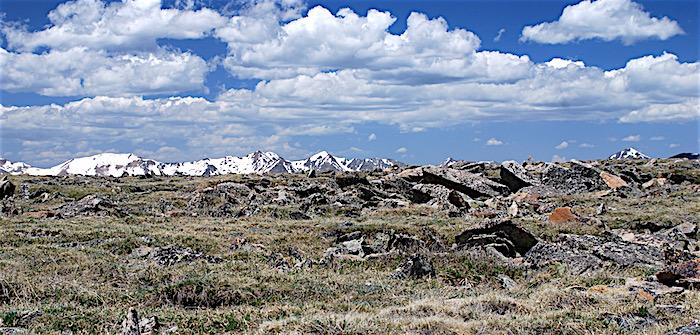
Climate change is imperiling pikas at national parks in the West/NPS, Will Deacy
At Grand Teton National Park in Wyoming, diminutive but outspoken pikas likely will endure what climate change brings to the park. At Rocky Mountain National Park in Colorado, however, they probably will not, according to a five-year study of the tiny mammal's Western populations.
The studies into pikas and climate change at eight units of the National Park System were compiled by scientists from the National Park Service and three western universities -- Oregon State, the University of Colorado at Boulder, and the University of Idaho. The research predicts a complex future for populations of the charismatic pika. The hamster-sized member of the rabbit family lives in rocky, icy patches in the western United States.
Funded principally by the NPS Climate Change Response Program, the studies carry predictions through the end of this century that vary by park because of local conditions such as elevation, weather patterns, and genetic diversity. In Grand Teton, the scientists expect pikas to survive because of the park's wet and cold conditions. However, the outlook isn't so great at Rocky Mountain, where they expect higher temperatures to cause habitat suitability and connectivity to decline.
“Because of this study, we can see that other factors, like habitat connectivity and gene flow, can influence the extent that climate change disrupts an ecosystem,” said Tom Rodhouse, an NPS ecologist and third author of the paper published Friday in the peer-reviewed journal Global Change Biology. “This knowledge can be used to develop management and conservation practices for the coming decades.”
The elusive creatures are a favorite of sightseers in high-elevation stretches of Rocky Mountain’s famous Trail Ridge Road, where pikas inhabit cold pockets in boulder fields and emit “barks” the sound of squeaky toys, a Park Service release said. But beyond the cuteness factor, the agency said, the pika is an important indicator of the overall health of mountain ecosystems. As climates change, higher areas in some parks may warm to the point that pika populations can no longer survive in them.
“In general, the availability of pikas’ preferred habitat – cold, high-altitude boulder fields – will decrease as temperatures rise in the coming decades,” said Donelle Schwalm, researcher at Oregon State University and lead author of the paper. “But even as we predict extinction of pikas in some parks, other areas will continue to provide adequate shelter for pikas to live and potentially thrive.”
Schwalm, Rodhouse and colleagues performed this research on pika populations as part of the Park Service’s Inventory and Monitoring Program, which collects, organizes and synthesizes natural resource data. Beginning in 2010, the researchers used field surveys, genetic analyses, geographic information and climate change forecasting in all eight parks to identify key risk factors that could threaten pikas’ survival.

Scientists don't believe pikas that live here, on the landscape surrounding Trail Ridge Road in Rocky Mountain National Park, will be able to survive climate change warming/Kurt Repanshek file photo
Each park in the study has unique conditions, so persistence of pika populations by the end of the century will vary from park to park. Here are brief outlooks for the eight parks in the study:
* Crater Lake National Park, Oregon – Pikas already occupy this park’s highest available habitat. Crater Lake is warmer in winter and cooler in summer compared to other parks in the study, and it receives the most snow. As snowpack declines, patches of pika habitat will become more isolated. Researchers predict a steep drop to less than 50 percent occupancy of remaining habitat.
* Craters of the Moon National Monument and Preserve, Idaho – This low-elevation park is warmer and drier than the others, and research models suggest a variety of scenarios for pikas. Because of the isolation of the pika population, low genetic diversity and small area of current distribution, researchers conclude the pika population is vulnerable to extirpation (local extinction).
* Great Sand Dunes National Park and Preserve, Colorado – Changes in precipitation will be important in this cool and arid park. Maintaining connectivity between habitat areas will be an important factor, but pikas are likely to persist in the northern half of the park.
* Grand Teton National Park, Wwyoming – Because this high-elevation park is so cold and wet, pikas live in warmer and drier areas. Large and well-connected habitat patches are likely to remain into the future, so pika populations are predicted to remain stable or increase.
* Lava Beds National Monument, California – Like Craters of the Moon, this low-elevation park is warm and dry. Surprisingly, models did not provide clear evidence of extirpation as the scientists expected. Inconclusive results may be due in part to the influence of sub-surface microclimates created by lava flows. Continued monitoring will better resolve the question of pika population vulnerability at Lava Beds.
* Lassen Volcanic National Park, California – Although this Cascade Mountains park is comparatively warm and wet, researchers anticipate long-term persistence of pikas here. This may be due in part to increased growing season and availability of forage plants.
* Rocky Mountain National Park, Colorado – Climate models say the predicted higher temperatures here will cause habitat suitability and connectivity to decline. Researchers conclude that pika populations in this park are highly vulnerable to extirpation.
* Yellowstone National Park, Wyoming – Like Rocky Mountain, Yellowstone is expected to become warmer and drier. Heat stress is an important factor making the pikas here vulnerable to extirpation. However, the current high genetic diversity in this park’s population may increase the species’ resiliency to heat stress.
More information about the Pikas in Peril project, including detailed results for each park, is available on the study website here.




 Support Essential Coverage of Essential Places
Support Essential Coverage of Essential Places







Comments
I'd have liked to know what they had to say about the pikas at Mt. Rainier, where their voices just echo all over the place at Paradise in June.